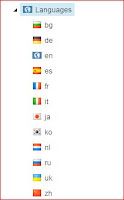EasyLingo, our first module on the Sitecore marketplace
Why
This language expansion module was designed to simplify content editing when using a large amount of languages in your Sitecore environments. When you have multiple sites with different language sets (e.g. a Belgian site in Dutch/French, a Swiss site in fr/de/it and a Danish site in dk/en) or simply a large volume of available languages, managing these languages in Sitecore can become cumbersome.
Sitecore has no out of the box functionality that restricts or manages the languages used per node/site and only offers the languages list to navigate through the available languages. The language list presented by Sitecore comprises of both those with one or more versions as well as those that have no version available or are irrelevant for that context/site.
This module was created on a Sitecore 8.1 platform together with my colleague and Sitecore MVP
Kris Verheire and is now available on the
Sitecore marketplace.
What
This module consists of 2 parts, which can be activated separately.
Extra languages section in the content editor
The bar consists of 3 language lists:
- On the first line, two of the lists are displayed. On the left hand side, the first list shows all the languages that have an actual version available.
- The right side shows the second list with all the languages for which a fallback version exists (working through Sitecore’s item fallback available as of version 8.1).
- The second line hold the third list that shows languages which are available on this node/site, but for which no version exists. This line will disappear if there are no such languages.
The versions with fallback on the right are rendered in italic. The current language on the Sitecore context is visualized in bold.

Languages in all the lists are clickable so the editor can easily switch languages without having to go through the whole list.
In order to get a nice view like in the screenshots it is necessary to manually set the icons of the languages in the system section of Sitecore (as Sitecore does not use these icons anymore in the list, they are not set by default. Flag-icons are still available though).
How are “available” languages detected?
We loop through the configured sites and check whether the current item is part of it (based on the
path in the content tree and the “rootPath” of the site). For each site we check if a custom property “allowedLanguages” is available in the SiteSettings specific site node. The distinct union of all these languages will be the list of allowed languages for the item. If the list is empty, all available languages in the Sitecore instance are allowed.
How to use the “allowedLanguages” setting?
The parameter will be part of a <site /> definition (just like hostname, database, rootPath and so on). It is not obligatory – the module works perfectly without it. It can be used for multi-site solution with different languages. For our example mentioned above we could have something like:
<site name=”Belgian” allowedLanguages="nl,fr-BE" … />
<site name=”Swiss” allowedLanguages="fr,de,it" … />
<site name=”Danish” allowedLanguages="dk,en" … />
The language should match the used language exactly (so “fr-BE” ≠ “fr”) and can be completely different or overlap. For the second part of the module it is important though to put the “default” language first.
Second part: request resolver
The second part of the module consists of a request resolver that is put in the httpRequestBegin pipeline after the LanguageResolver.
The current requested URL is checked to disable the functionality for Sitecore URL’s or when not in normal page mode. The current context site is checked for the ‘allowedLanguages’ parameter. If found, and the current language is not part of the ‘allowedLanguages’ set we will redirect the user to homepage in the default language (default is the first language in the set).
Future features
The EasyLingo bar is now only available in the Content Editor. The next step would be to introduce a language bar in Sitecore’s Experience Editor that allows users to quickly switch between the available and allowed languages for the content they are editing. (is already in progress)
We are also working on adding versions of items in languages that are not listed in the system languages.
More information


